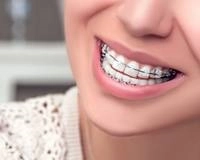Archwires
The bendable metallic wire linking the brackets in ceramic braces can also be crafted in a lighter hue.
Color options consist of white, silver, or a frosted shade
that complements the brackets.
The combination of tooth-colored brackets and wire means that your ceramic braces may be nearly invisible to
others. This choice is favored by working adults or
college students
seeking straight teeth while avoiding the appearance of traditional braces.
Durability
Ceramic braces are not as strong as metal ones. The material of the brackets in ceramic braces is weaker
than stainless steel. Research shows that these clear or
ceramic brackets are more likely to break or fracture.
They are over twice as likely to have issues compared to metal brackets. Because of this, taking good care
of them and following guidelines is very important. To
avoid breaking them, avoid eating any crunchy foods or hard candies.
Staining
Ceramic brackets can stain easily due to their lighter color and may affect tooth movement. To prevent
staining, limit consumption of dark foods and drinks like
coffee, tea, red wine, ketchup, and curries. Use a straw when drinking, brush and floss teeth after eating
or drinking to reduce stains, maintain oral health, and
avoid gum disease. It's also a good idea to check your dental insurance for brace care coverage, but
remember that diligent oral hygiene is essential during
orthodontic treatment.
Enamel Wear
Ceramic braces on both upper and lower teeth can cause enamel wear, particularly on the back of the top
teeth, due to their abrasive material. This may lead to tooth
decay if not cared for properly. Patients with excessive overbites might benefit from getting metal braces
on their bottom teeth to protect their oral health.
Cost
The increased expense arises from the use of a more delicate and costly material in crafting the brackets.
Ceramic braces typically cost between $3,000 and $7,000. This price covers the braces, office visits to the
orthodontist, and aftercare like retainers. In comparison,
metal braces range from $1,700 to $6,000 for the same services. This information is essential for a ceramic
vs metal braces cost comparison.
Get the full scoop on braces
treatment




